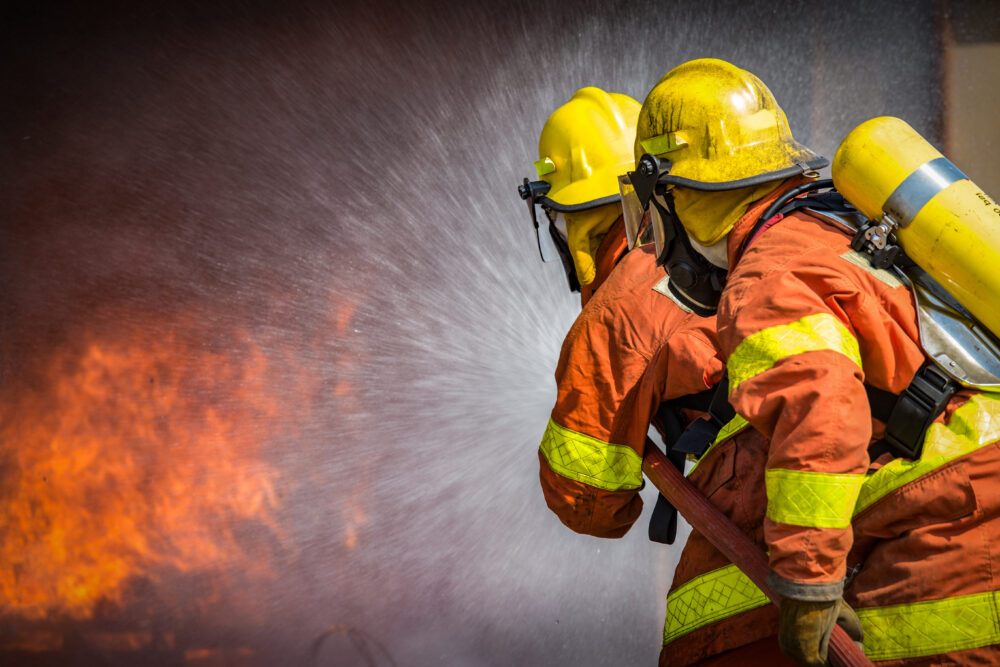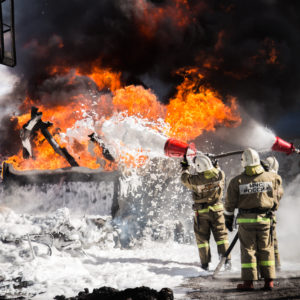Firefighter Turnout Gear Study Finds High Levels of PFAS Chemicals in Water Repellant Fabrics
The findings come amid growing concerns that toxic PFAS chemicals in firefighter turnout gear may increase cancer risks.

A new federal study on firefighter turnout gear has identified ways to eliminate and reduce the presence of some per- and polyfluoroalkyl substances (PFAS), which may be toxic and contribute to unusually high firefighter cancer rates.
Researchers working with the National Institute of Standards and Technology (NIST), a federal agency, report that much of the PFAS present in firefighter turnout gear, the name for their protective clothing, comes from water repellants used to keep moisture and chemicals away from the body.
The institute issued a press release May 1, indicating it believes the findings can be used to reduce the amount of PFAS in firefighter turnout gear layers that are closest to the body. However, it may take time to find a safe, and effective, replacement for the water repellents currently in use. The findings were published this month in an NIST Technical Note (PDF).
Firefighter Turnout Gear PFAS Concerns
PFAS are commonly called “forever chemicals”, since they are known to persist in the environment and build up in the human body, causing a number of different types of cancer and diseases. However, they have been widely used in recent decades in both aqueous film-forming foam (AFFF) used to fight petroleum-based fires, as well as firefighters’ turnout and bunker gear.
In August 2022, the International Association of Fire Fighters and the Metropolitan Fire Chiefs Association issued a warning to firefighters, calling for them to reduce their PFAS exposure by limiting their use of turnout gear. The groups warned that firefighters will not be able to fully avoid the PFAS cancer risk until the chemicals are removed entirely from protective gear, but they called for the development and widespread availability of such gear. In the meantime, the group indicated that firefighters should limit the use of turnout gear to only emergency situations where it is required, and then suggested fire fighters remove it as soon as possible.
Manufacturers of PFAS chemicals and safety equipment now face thousands of firefighter cancer lawsuits, involving allegations that years of exposure to the chemicals caused testicular cancer, kidney cancer, pancreatic cancer, bladder cancer and other injuries. Although the manufacturers knew or should have known about the PFAS cancer risk, fire fighters allege they withheld important safety information and warnings for decades.

Learn More About
Exposure to firefighting foam chemicals may result in an increased risk of cancer for firefighters, military and airport personnel.
Learn More About this Lawsuit SEE IF YOU QUALIFY FOR COMPENSATIONFirefighter turnout gear generally consists of three layers; the outer shell, the moisture barrier, and the thermal liner. Researchers tested samples from 20 textile samples, representing fabrics used to create all three layers. They then tested them for the presence of more than 50 different PFAS chemicals; some of which are suspected to be toxic.
The results varied widely by textile sample, the researchers indicate. However, they were able to identify 26 different PFAS and found that, in general, the outer shell and the moisture barrier contained the highest amounts of the “forever chemicals”.
In some samples, the amount of PFAS in the outer shell and moisture barrier were 400 times higher than those used for the thermal liner, with the outer shell having the consistently highest PFAS levels. However, the thermal liner also often had some levels of PFAS as well, just significantly lower amounts than the other two barriers.
The researchers determined this was the result of the heavy use of water repellant chemicals on the two outermost layers. Water repellency is not a high priority for the innermost layer, they noted.
“If you changed to a non-PFAS water repellant coating on the outer shell, then you essentially eliminate PFAS from that layer. There isn’t much in the thermal liner to begin with. So really the one layer left to address is the moisture barrier,” Rick Davis, an NIST researcher and study co-author said in the press release. “On paper this sounds easy to solve — just use a non-PFAS based water repellent — but we need to know we aren’t just swapping out one risk for another.”
The researchers noted that they still have to determine how much firefighter PFAS exposure is from other chemicals, like firefighting foam, and how much those exposures actually affect their health. However, they said the findings will help the NIST create a list of recommended fabrics to use for each layer to minimize firefighter turnout gear PFAS exposure.
Fire Fighter PFAS Exposure Lawsuits
Claims brought throughout the federal court system against 3M Company, DuPont, Tyco Fire Products, Buckeye Fire Equipment Company, Kidde-Fenwal and other manufacturers of firefighting foam and protective equipment are now centralized in the U.S. District Court for the District of South Carolina, as part of a federal MDL or multidistrict litigation, since they each raise common questions of fact and law.
In addition to fire fighter lawsuits over the PFAS cancer risk, the litigation also includes a number of complaints brought by local water suppliers over the costs associated with removing PFAS chemicals from their water systems. The companies also face potential PFAS water contamination lawsuits that are now starting to be pursued by individuals who lived in areas that are known to have high levels of the chemicals in their water, usually around military bases, airports and other fire fighter training locations, where the chemicals seeped into the water supply.
As part of the coordinated management of the growing litigation, the U.S. District Judge presiding over the cases has established a “bellwether” program, where a small group of water supplier lawsuits are being prepared for early trial dates before lawsuits over the fire fighters cancer risk from AFFF are scheduled, to help gauge how juries are likely to respond to certain evidence and testimony that will be repeated throughout the claims.
Get more articles like this sent directly to your inbox.
"*" indicates required fields






0 Comments